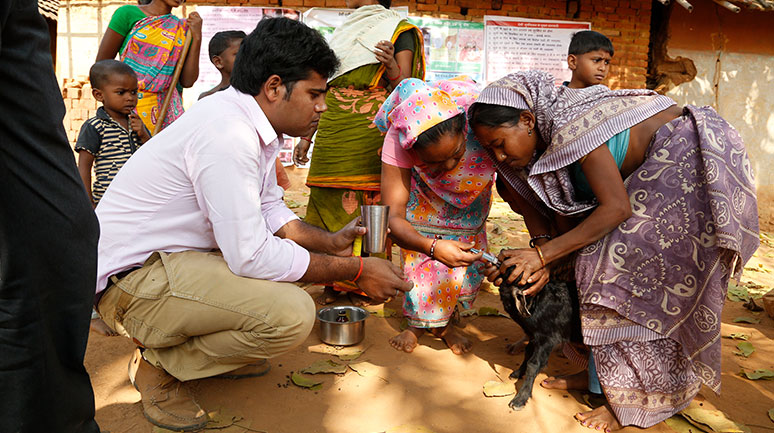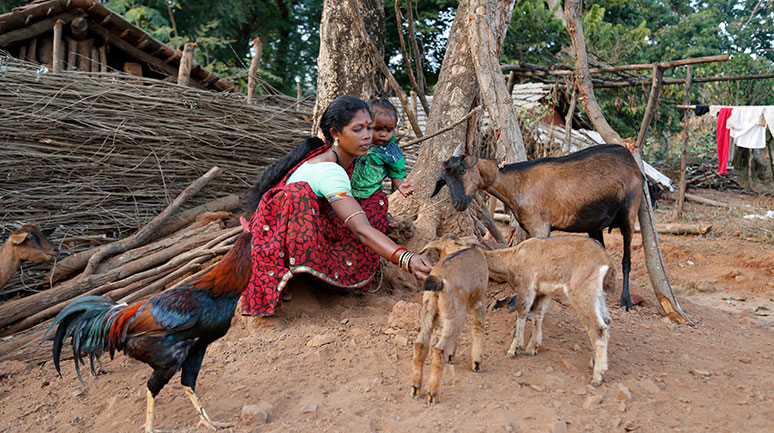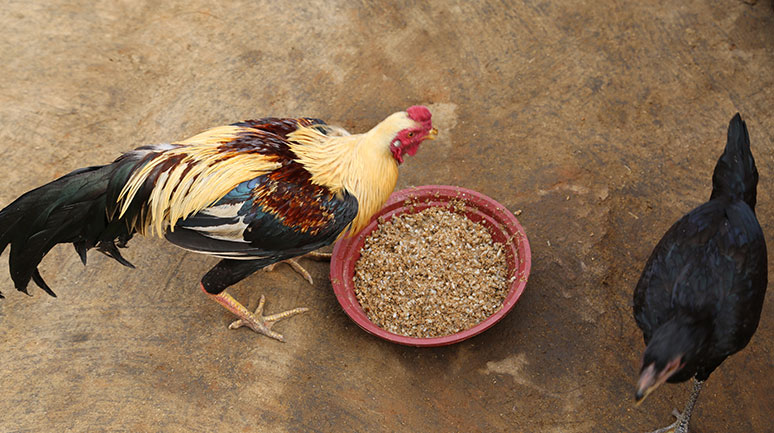Rearing Small Livestock: A Source of Nutrition and Income


Focusing on a much-neglected activity—small livestock rearing—and adopting modern methods under the guidance of trained Community Animal Health Workers has brought about a sea change in the lives of the villagers, who were hitherto buffeted by the vagaries of the weather and annual disease outbreak
I had 30 backyard poultry birds and four goats. I was expecting an income of Rs 16,000 by selling the stock. But the sudden outbreak of Newcastle and PPR diseases killed 25 birds and all the four goats. I tried everything to save the animals. The local practitioner took a hefty amount as fee but nothing happened. We were broke. It was a very difficult situation. We were in debt,” recounted Laxmi in grief.
Laxmi’s family has still not recovered from the loss. Like Laxmi, many other families in this remote village - Kusumba of Kathikund district in Jharkhand—had suffered these sudden losses. “There is high risk in livestock-rearing and that is the reason we are afraid to increase the stock,” says another farmer.
Even though people suffer heavy and sudden losses in livestock-rearing, small livestock-rearing is one of the major sources of livelihood for the families in Kusumba village. Livestock is intrinsic to the family’s culture and is a reflection of their socio-economic status. Explaining the importance of livestock in their life, SHG members say, “In spite of the mass mortality of animals, we do livestock-rearing because it gives us a social prestige. We sacrifice the birds during festivals such as Gawali Puja, Bandana Parab, Sohray, Bada Din, Kali Puja, Durga Puja, Khamar Puja, Surjau Puja. When guests come home, we serve them meat from our own stock, as our way of honouring our guests. We do not buy meat from the market.” In a good season and on an average, families earn around Rs 15–25,000 per annum from livestock-rearing, depending on the stock size.
In a good season and on an average, families earn around Rs 15–25,000 per annum from livestock-rearing, depending on the stock size
I n a good season and on an average, families earn around Rs 15–25,000 per annum from livestock-rearing, depending on the stock size. SHG members say livestock-rearing, especially backyard poultry rearing, can be managed by anyone very easily because the labour required is not much and the input costs are not very high. Birds and goats graze freely and are supplemented with a little bit of stall feeding. Birds roam around in backyards whereas goats have to be taken to the forest for grazing.
Livestock is raised in mixed farming systems; these activities are normally integrated into the existing farming systems: produce meat, eggs, surplus stock, use of fertilizer, etc. Backyard poultry and goats can be kept on small farms that do not have large fodder resources. Farmers do not require much technical knowledge. It is a simple practice, usually carried out by women.
Many consider small livestock as their ATMs (Automated Teller Machines) because one can easily sell the stock, in case of any exigency. Women often prefer to engage in livestock (small ruminants and poultry) to other livelihood options. This helps them establish their identity as farmers.
Small livestock, although an important component of the poor people’s economy, has largely been neglected by policy-makers, researchers and practitioners. Agriculture has mostly been limited to cultivation whereas livestock (especially small livestock) has always been given step-motherly treatment. Cultivation is seen more as the men’s domain, and small livestock-rearing falls under the purview of women. That may also be the cause for neglecting it and treating it as an insignificant economic contributor with very little scope of growth.
In Kusumba village, the women’s collective-led livestock-rearing activity started with a discussion among the members of a Self- Help Group (SHG) in a Village Organization (VO, called Naya Kiran Mahila Gram Sangathan, Kusumba,) meeting when planning for livelihood options. Many families have very little land whereas some are landless. Agricultural activity is rainfall dependent with very little contribution to household income.

Members identified that the critical gap in their activity was due to improper rearing and non- availability of preventive and curative health services, resulting in the mortality and morbidity of livestock. Two members from the VO were selected to become CAHWs after some training.
Members identified that the critical gap in their activity was due to improper rearing and non- availability of preventive and curative health services, resulting in the mortality and morbidity of livestock. Two members from the VO were selected to become CAHWs after some training
T he topography of the village, like many villages in Kathikund block, is undulating in nature. Families find it difficult to irrigate their fields. Less than 10 per cent of the area has irrigation facilities and people are heavily dependent on rain for cultivation. With such uncertainty in farming, families choose other options such as livestock-rearing, labour work or stress migration to make both ends meet. Whereas labour and migration are common among men, women are mostly engaged in livestock-rearing. Livestock- rearing provides them cash, which helps families in distress. However, because mortality rates of livestock are very high, rearing livestock are also uncertain. Families are wary of increasing their livestock, fearing frequent epidemics.
A baseline survey was conducted on livestock-rearing in the panchayats of Bartalla, Dhawadangal and Jhikra; Kusumba village falls under Bartalla gram panchayat. The study revealed that families, on an average, rear 16 birds, including chicks, and five goats. At least twice a year the birds are afflicted by Newcastle disease, leading to the death of about 80–90 per cent of the poultry. Fowl-pox occurs at least once a year, affecting 40–70 per cent of the birds. Similarly, PPR in goats occurs every alternate year, resulting in the mortality of about 60–90 per cent of the goats.
The current support system from the veterinary department is not efficient and there are not enough Livestock Inspectors (LIs) for all the villages. The veterinary official’s visits to the Block Veterinary Hospital are limited to once a week. Many families, therefore, rely on quacks, who charge hefty amounts for treating birds and goats without any guarantee of results.
The same situation was observed in the villages of Patna block, Kendujhar district in Odisha. Due to the continuous efforts of the women of Baitarni Mahila Sangh (BMS)—a block-level Federation—and support from PRADAN, the mortality of the livestock has been controlled. An exposure visit was planned for the representatives of Naya Savera Mahila Sangh (NSMS), Kathikund, to understand the intervention in Keonjhar district.
In Patna block, women are doing integrated livestock activity collectively. The services of the Animal Husbandry Department being poor, the Federation has created a revenue-based system to provide the services at the doorstep of its members. Community Animal Health Workers (CAHWs) have been selected from the village and trained to provide regular health services to farmers. The intervention started with the objective of meeting an additional Rs 15,000 income for families, after household consumption. Another important objective is to enhance the buffer stock of livestock, to make it a robust and reliable coping mechanism against financial stress. As a strategy, the Federation is working to cover all areas and is providing veterinary care services at the doorstep such as on-time vaccinations and deworming, maintaining the cold chain and arranging for regular interaction between the CAHWs and the farmers. Currently, around 1500 families in Kathikund area have adopted the improved practice of integrated livestock-rearing and have realized the benefits.
Currently, around 1500 families in Kathikund area have adopted the improved practice of integrated livestock-rearing and have realized the benefits
T he visit to Kendujhar had a very motivating effect on the Federation representatives. They shared their experiences and impressions of the visit with other members at the VO meeting. Members identified that the critical gap in their activity was due to improper rearing and non-availability of preventive and curative health services, resulting in the mortality and morbidity of livestock. Two members from the VO were selected to become CAHWs after some training. Trainers were called from Kendujhar. They stayed in the village and guided the CAHWs on how to provide services to the farmers. In all, 13 CAHWs and two master trainers were trained, to ground the activity.
With the help of trained para- vets, an awareness camp was organized at the village level. Flex, videos shows, role-plays and mass awareness camps were used to create awareness among the farmers. These village- level meetings helped farmers understand the situation and they learned that they could earn profits if proper health-care was ensured for the animals.
To begin with, birds and goats were de-wormed. When the farmers became confident, they were entrusted with vaccinations for diseases such as Newcastle disease and PPR, pox. The farmers readily paid the cost of the services, which was kept at Rs 25 per animal. The results were soon to be seen. In the next three months, although the disease spread in the area, the mortality rate decreased drastically, in comparison to earlier times. The difference was also visible when compared to the villages where health services were not initiated. With low mortality of livestock, the farmers were more confident about investing in increasing their stock of birds and goats. Reduced mortality and increased stock helped the families gain substantial profit from the activity.

“Every year my birds and goats used to die due to disease. I was left with only two hens and one goat. Now I have 19 birds and six goats. Our CAHW has trained us on how to take care of the livestock. She has explained to us when to give them medicine, what sort of care needs to be given and also how to take care of their feed and shelter house. All our SHG members save some amount of money for vaccination and deworming. We pay Rs 2 per hen and Rs 7 per goat,” said Kadmi Devi.
Sonoti Mohli from Kusumba village said, “Our CAHW visits us regularly. He gives us training on proper rearing of livestock.Developing a sustainable delivery mechanism is very critical for the activity. Regular and timely services are provided at the doorstep. A cold chain unit is being managed by a local entrepreneur, who coordinates between the medicine supplier and the CAHW.
Developing a sustainable delivery mechanism is very critical for the activity. Regular and timely services are provided at the doorstep. A cold chain unit is being managed by a local entrepreneur, who coordinates between the medicine supplier and the CAHW
"We give timely medicines to our livestock and have even made separate sheds for goats and hens. I have 12 hens and five goats now. We regularly consume eggs and meat, and this year earned Rs 7000 by selling my livestock."”"
D eveloping a sustainable delivery mechanism is very critical for the activity. Regular and timely services are provided at the doorstep. A cold chain unit is being managed by a local entrepreneur, who coordinates between the medicine supplier and the CAHW. The CAHWs meet the SHGs once a month to discuss any health issue. SHGs collect the money from the farmers for the services received and pay the CAHWs. All CAHWs hold a monthly meeting at the Cluster level for planning and placing orders for medicines and other support services required. They are regularly trained by master trainers and external resource persons.
On an average, farmers earned Rs 10,000 in an year excluding the present stock and their own consumption. The yearly incomes are expected to rise in the next two to three years as the stock size of the livestock increases gradually. Women farmers are especially happy because the income directly comes into their hands and they are able to meet their own needs and the needs of their children. The consumption of birds in these families has increased; on an average, each family consumes two or three birds a month and regularly consume eggs.
After this initiative of the Collective, the men of the community have begun showing an interest in learning about livestock and helping women take up livestock-rearing because it presents an opportunity for livelihood. The initiative is being taken forward in other villages such as Kanahidih, Chichro, Bada Dhaniyapahari, Jamchua and Jhikra. Currently, around 1500 families in Kathikund area have adopted the improved practice of integrated livestock-rearing and have realized the benefits.
Ashish Kumar is an Executive with PRADAN and is based in Kathikund block, Jharkhand

